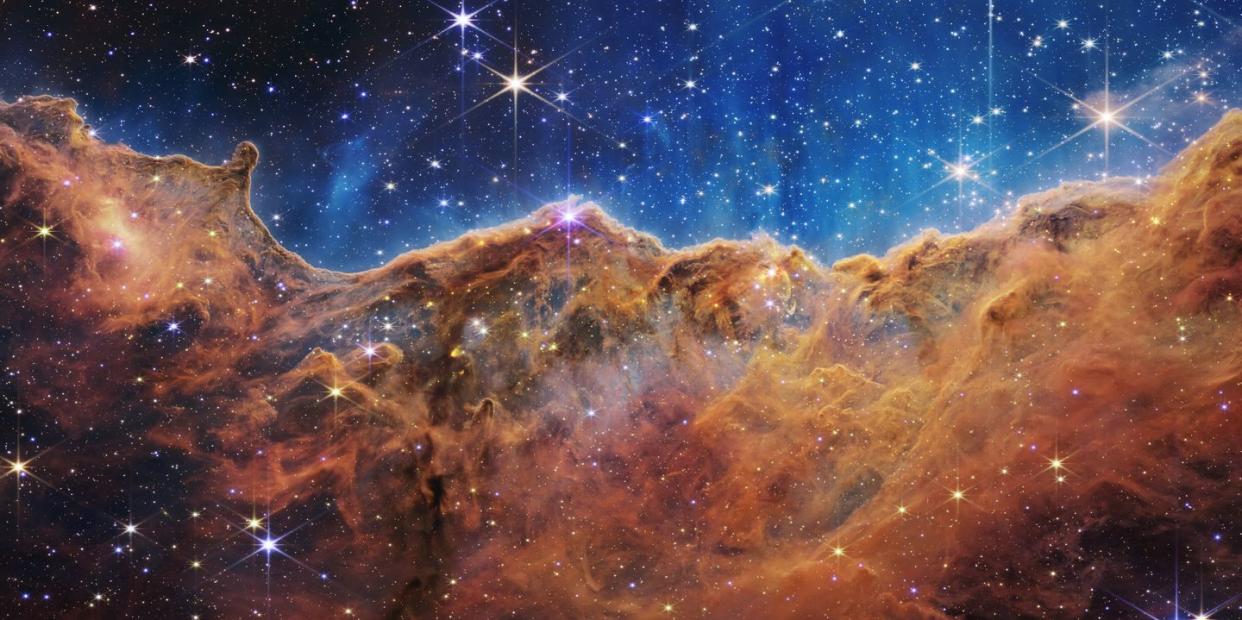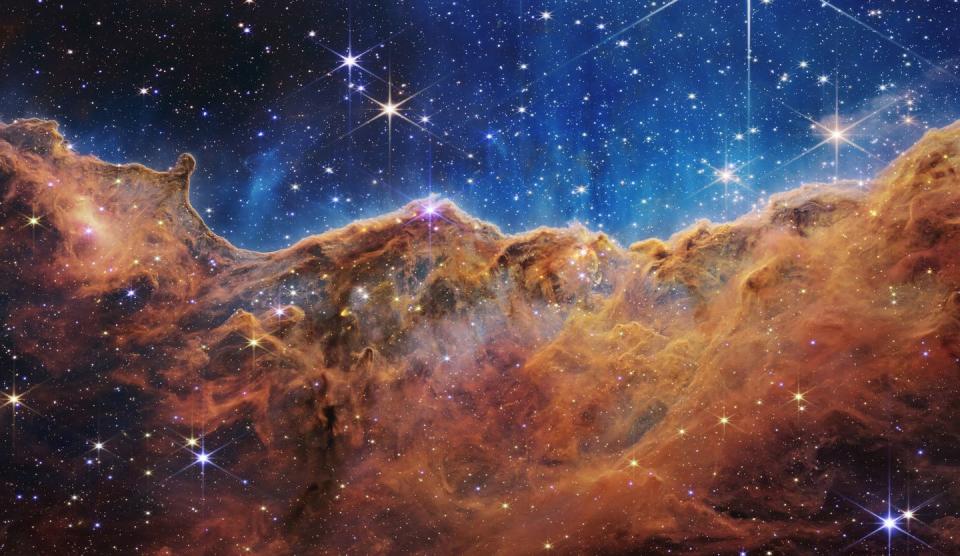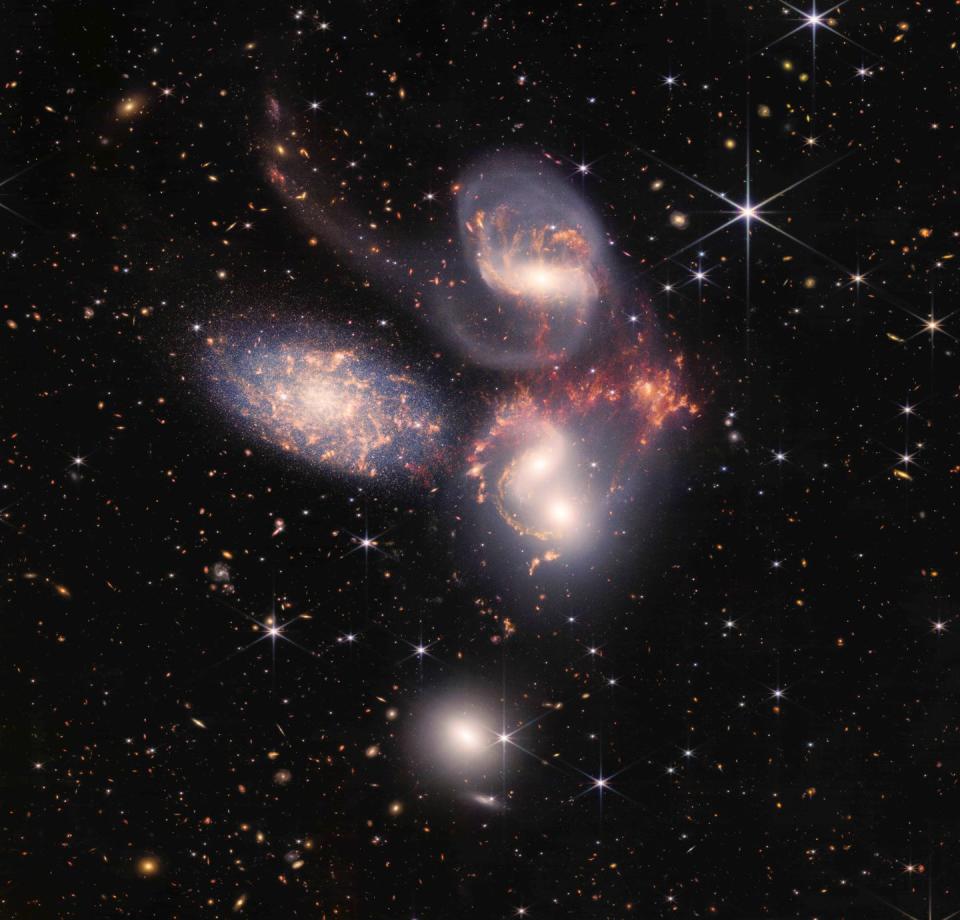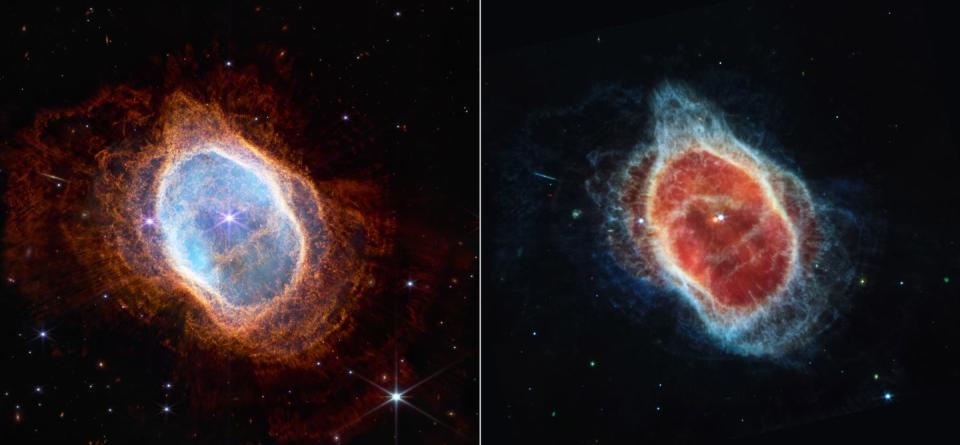The Webb Telescope's Photos Emphasize That Basic Questions About Our Existence—and Time Itself—Are Wide Open

Maybe telling people they're ants on a tiny rock in one solar system in a galactic backwater wouldn't be great politics. But operating on this knowledge, that our existence is so unlikely and finite and delicate in the face of all there is, would encourage us all to start working together to keep ourselves and our species in the game. Certainly, when you really process the distances between us and anything else—forget a place we might actually want to live, and no, Mars does not qualify—you really start to appreciate our nice little planet here and the opportunity we have to live on it.
These are the kind of things that come to mind for me when I look at the first five photos from the the James Webb Space Telescope, released this week along with stats and facts that will put your brain in a pretzel. So-called "Cosmic Cliffs" that are 7 lightyears high, when one lightyear is about 6 trillion miles. A snapshot of a thousand galaxies or more, each containing billions of stars, that actually "covers a patch of sky approximately the size of a grain of sand held at arm’s length by someone on the ground."
These considerations are where astronomy bleeds into philosophy. As Harvard University physics lecturer Jacob Barandes explained when we spoke on Thursday, these aren't just questions of our existence, or the silly question of whether there is other intelligent life out there. (There is.) What we've learned relatively recently calls into question the very idea that "now" is different from "then." Our conversation has been edited for length and clarity.
When I look at something like the Carina Nebula, I always think about how something that’s 7,200 lightyears away, what you’re actually looking at is the thing as it was 7,200 years ago. What comes to mind for you?
It reminds me just how limited our epistemic access is as human beings. We're looking at the world, and we’ve used our eyes for most of human history. We've developed fancy technology, space telescopes. And if you just think about what we've been able to gather throughout all that time, it's an incredibly thin sliver of information about what's out there. From what we understand about the observable universe, everything you can see goes back about 13.8 billion years, but we're only able to see what light has arrived at us from visible matter in the very short span of human history. It's an incredibly limited amount of information, right?
When you extend these sorts of questions to objects that are tens of millions, hundreds of millions of light years away, like Stephan's Quintet, or the galaxies at the very edge of our view—now you're exceeding 13 billion light years away. Now you're seeing objects as they were in the very early universe. And what that makes very clear is that we are eventually going to hit a wall, right? We're not going to be able to see greater distances than there has been time for light to reach us since the universe, at least the observable universe, began in the Big Bang. And that means that we have what's called a cosmic horizon. The edge of what we can ever see.
To me, it drives home a proper amount of humility, and also a clear sense of our fallibility. Not only do we not know, but we should be careful about what we claim to know.

I mean, it wasn't long ago that we discovered that 70 or 80 percent of the matter is dark matter that we seem to have no way of really observing in any traditional sense. Right?
About four percent of the mass energy in our universe is made up of ordinary kinds of matter that we're familiar with, matter made of atoms. So people and planets and animals and clouds and gas and dust and stars, asteroids. Another roughly 25 percent of the mass energy content of the universe appears to be some other form of matter that is not made of the particles of the standard model, not made of atoms, not made of protons or neutrons or electrons or any of the familiar kinds of things. We know of its existence indirectly through its gravitational pull. As far as we can tell today, dark matter interacts with itself and with regular matter only through gravitational influence. The light passes right through it. You might even better call it invisible matter.
And then the 70 percent of the rest of it is even more bizarre. It's not even dark matter. It's a kind of pervasive uniform energy that is intrinsic to space itself. And because we don't know what it is, we just call it dark energy. And it's actually distinct from dark matter. At least we think it is. It behaves quite differently from dark matter. It doesn't clump together the way dark matter does, gravitationally. And it exerts a kind of anti-gravity effect on everything. The dark energy is powering an accelerated expansion of the universe, making the universe expand ever more quickly. And we don't know what it is.
So remarkably, not only do we have such limited epistemic access to visible matter, but we can't directly see 95 percent of the mass energy content of the observable universe around us.
I was looking at Stephan's Quintet and found there’s a super massive black hole at the center of the top galaxy among the five. It’s apparently 24 million times the mass of our Sun and emits light energy equivalent to 40 billion Suns. It’s beyond comprehension.
It is. The black hole itself is not emitting the light because as you know, black holes, once something falls in, they don't come out again. But black holes are very messy eaters. As stuff falls into a black hole, it speeds up. And that interaction generates extremely highly energetic radiation that escapes before it plunges in. So yeah, black holes rather paradoxically can be incredibly bright, even though once you actually fall in, you don't come out again.
The Milky Way's super massive black hole is located in the Sagittarius constellation. Does that say anything about me as a Sagittarius?
Well, are you a very needy person? Are you very greedy?
But no. What I think is really fascinating about these pictures—and I think Stephan's Quintet really gets this across—is that when we look at the night sky, we see what looks kind of like a painting, like a two-dimensional image, but wrapped around us, wrapped around the sky. This image is known as the celestial sphere, because it's kind of an optical illusion. If you look at the night sky or the daytime sky, it looks kind of like a dome. And whether you're looking in the daytime at the clouds, or you're looking at nighttime at the stars, these appear to be painted on the dome like the ceiling of the Sistine Chapel.
And when you look at Stephan's Quartet you see a bunch of galaxies that look like they're all part of one group, right? There's a bunch of objects all painted together. But the galaxy on the left in Stephan's Quartet is much closer to us than the other galaxies, 200 million light years closer. It's about 40 million light years away from us, and the others are about 290 million light years away. And what’s amazing about this image is you can see that difference in relative distance from us because the galaxy on the left is close enough that the James Webb Space Telescope was able to resolve individual stars in it. The galaxy on the left is not just a cloudy smudge. You can discern stars in it—many, many individual stars. You can't in the other galaxies. That just gives you a sense of how much closer it is than the other galaxies in the picture.

It's a really important reminder that this two-dimensional projection that we're seeing on our celestial sphere, on the sky, is an illusion. These are three-dimensional arrangements of objects, sometimes with enormous distances between them, in that third dimension that we are unable to perceive directly. The Sagittarius constellation is a very nice example of this. The constellations look like two-dimensional pictures, but some of the stars are way closer to us and others are very, very far away. An image like Stephan's Quartet really drives home our very artificial perspective.
They call the Carina Nebula “the Cosmic Cliffs,” and it does look like mountains. But it struck me that we’re constructing these things so that our minds can grapple with it, because then it looks like something we're used to here on Earth. We're creating these patterns in order for us to latch onto them.
Yeah, exactly. We're mapping it onto concepts that we can grasp, except that the mountaintops, those peaks in that picture, are seven lightyears tall. A lightyear is 6 trillion miles. Our whole solar system is a few billion miles in radius. The nearest star beyond our sun that we know of, the Alpha Centauri star system, is about four lightyears away. So that mountain peak is much, much larger than the distance from us to the nearest star other than our sun. And that means of course, that when light is emitted from one part of that mountain peak, it takes seven years, even traveling through the vacuum of space, for that bit of light to get down the mountain peak. The speed of light seems very fast. But in the context of the universe, the speed of light is painfully slow.
Looking at these, I’m reminded of all the absurd conversations about whether there’s intelligent life out there. It’s inevitable. But the more interesting thing to me is, why would we not interact with anyone? And one explanation is that if we saw another civilization somehow that was lightyears away, by the time we're seeing them, they may well have destroyed themselves. Then there’s the time it would take for them to come here and see us.
If another civilization got just a little bit of a head start on us, if another civilization came into existence one percent earlier in the history of the universe, that’s roughly 140 million years. So a civilization that started one percent earlier would have 140 million years on us in terms of development. Either it would be so fantastically more advanced than we could possibly imagine, or as you somewhat dismally indicated, it might have wiped itself out. Enrico Fermi, the quantum nuclear physicist, asked many decades ago why we haven't detected any intelligent life in the universe. And this became known as Fermi's Paradox. Given how big the universe is and how long the universe has been around compared with human history, you might expect there to be a lot of civilizations going. Why haven't we seen them? And one argument was exactly what you just said, which is maybe civilizations have a finite lifetime. Heaven knows, we've had some close calls.
We're well on our way and we're not very old.
Right, exactly.
Scientists use these snapshots and data and the laws of physics to extrapolate what happened before and after. Do our continual findings have us questioning any of those laws of physics that we use as a bedrock? Does dark energy and dark matter change anything for us? As I understand it, even Einstein's work increasingly comes under pressure, just the more that we learn.
As best we know, there are no smoking gun signals from actual observational data that Einstein's theory of gravity is incorrect. It has survived many, many tests at this point. But you're absolutely correct that dark matter and dark energy put pressure on general relativity. In a way, calling these things dark matter and dark energy is basically granting that general relativity is functioning properly and is providing us with a correct set of laws. And the strange behavior we see in the universe that we ascribe to dark matter and dark energy is within the context of assuming the validity of general relativity. If you insist that general relativity is functioning as it should, then you need dark matter and dark energy to explain many of these strange observations.
To sort of balance the equation.
Exactly. I mean, dark energy was first introduced under a different name by Einstein himself. He called it the cosmological constant, and he introduced it precisely because he was trying to make the universe conform to his theory. Back when Einstein proposed it, it was not known the universe's size was changing. General relativity implies the universe's size should be dynamic, it should be collapsing or expanding. This was not known to be true. So Einstein inserted the cosmological constant, which we would now call the dark energy. He inserted it to, exactly as you said, balance things out, so the universe would remain the same in size.
It didn't work very well. The balance you get is highly unstable and does not persist through time. And in the end, observational evidence indicated the universe was not static, it was expanding. And so Einstein threw it out. "Oh, we don't need this anymore." In a way, we've come back to it, because the expansion that we see is kind of strange. After decelerating for most of the universe's history, over the past billion or so years, the expansion has been accelerating. It'd be like throwing a baseball in the air and it slows down as it goes up in the air as you'd expect, and then it reaches a certain height and then it starts to take off and accelerate into the sky.
Now, one thing you could say is maybe gravity's wrong. Alternatively, you could say, "No, gravity is right. Our theory of gravity is right, but maybe there's something powering its sudden acceleration into the sky." That's essentially what dark energy's doing, only it's obviously a much more sophisticated kind of arrangement.
An alternative is to say, maybe there is no dark matter or dark energy, and maybe general relativity is simply wrong. There have been proposals over the years to this effect. There's a long running proposal called Modified Newtonian Dynamics, or MOND, that claims to banish the dark matter. It entails modifying general relativity, changing the laws of physics, so that dark matter would be unnecessary.
I am not an expert in alternative theories of gravity, nor am I an expert on MOND, but my understanding is that it is experimentally disfavored today. The evidence for dark matter comes from so many different directions, and positing that there's just some other substance that only interacts gravitationally as far as we know, in the context of Einstein's general relativity, correctly accounts for a tremendous number of diverse phenomena, much better than alternative theories of gravity do. So, the consensus these days is that general relativity is working out fine and there's just a lot of invisible stuff, dark matter, and dark energy, causing strange things to happen.
What about the technological feat of this telescope?
Unfortunately, I'm the wrong person to ask this question. I can't even fix a toaster oven. I can tell you things you’ve already read about, that it’s 100 times as strong as the Hubble, that these images took way less exposure time to obtain. The SMACs image–that corresponds to a portion of the sky that would be covered up by a tiny grain of sand on the tip of your finger if you extended your arm. And what this gets across is that the sky is just filled with galaxies. That image of a dying star emitting that huge billowing cloud of gas and dust, you can see galaxies in that image. In fact, there's this one horizontal streak—I know this because I watched the live broadcast when they were announcing the results. If you look at the left of the left image, you see this very clear, large white line segment. And that's a galaxy seen edge on. It's a disc galaxy.

You can't throw a rock without hitting a galaxy. And when we look at the night sky, we don't really have that sense. These days, with light pollution, you can barely even see any stars. But if you could somehow light up all the galaxies, the sky would just be a solid, glowing sphere. It's like our celestial sphere, our dome in the sky, is like a fine-grained mosaic of distant galaxies.
All of which contain huge numbers of stars, each of them.
Millions, billions, hundreds of billions, maybe even more stars. And what these images get across to us is the subtlety of our relationship to the rest of the universe in time. We have a certain intuition about how time works from our everyday life. We have some intuition that time passes the same way at a physical level, maybe not at a psychological level. But that time passes the same way for all of us. it's very difficult to sharply explain what it means when you talk about the rate at which time passes. I mean, if time passes one second per second, what does that even mean? But we also have this sense that we share a common present.
There is a philosophical position known as presentism, and it's something that I'm pretty sure most people accept just intuitively, that the present is a meaningful concept. The present is a real thing that we all share, and we don't really know about the past or the future. The past is passed. Maybe the past isn't even real anymore, but certainly the present is real. And we have this sense that the present is constantly moving forward. It's becoming the future. It's ceasing to be the past.
Well, this picture is all well and good on the Earth. But when you consider an object over 7,000 light years away, like the Carina Nebula, you run into some very basic questions about whether our notion of the present really reaches out to an object that far away. Naively, the answer is yes, of course. I mean, after all, when you say you're seeing it as it was 7,000 years ago, this presumes that there is a way it is now, in our present, that is not the way it looks 7,000 years ago. In our present, it could look very different. We're seeing an ancient image of what it looked like 7,000 years ago.
But it's actually not trivial to extend our notion of the present all the way out that far. And this is due to Einstein's relativity. This isn't even general relativity yet. This is actually his earlier theory, his theory of special relativity, his pre-gravitational theory of space and time. What Einstein showed is that the notion of the present is relative to the observer. In particular, it’s relative to the observer's state of motion.
If you take a walk, and you walk, I don't know, a foot per second, a couple of feet per second, the most natural way to extend your sense of the present to the Carina Nebula shifts. If you change direction and walk the other way, the effect reverses. Now, a few seconds is not that much, and you need an object very far away for there even to be discrepancies of a few seconds in past or future or present. But what this indicates is there is an ambiguity. There's an ambiguity in what you would call your shared present. Simply by changing your state of motion, walking towards the Nebula or away a few feet per second, you can wiggle the future and past of that object back and forth.
And so there isn't a sharp unambiguous sense in which it has a definite shared present with you. And this effect becomes more significant the farther way the object is and also the faster you move. If you get in an airplane and you're going really fast, you can wiggle the future and past of that object quite a bit more. As the airplane turns around and moves at high speed in various directions, things that you would've before said were in the future of that object are now in its present, or maybe now in its past, by more than a few seconds. And for objects farther away, it could be minutes.
Is that tied to this notion of spacetime, where we think of space and time as separate in our relatively small environment here on Earth, but as the distances get greater, there starts to be less of a dividing line between them?
That’s right. This is called the breakdown of simultaneity. Simultaneity is another word for the present. Simultaneity is now a relative concept that depends on your state of motion. And I think one of the things that is most striking about this from a philosophical point of view is it makes it difficult to avoid reifying the past and future, making it real. If I can make something a few seconds in its own past part of my present by walking in the other direction, it becomes very enticing to say that the past and the future of that object—and therefore, by extension, all objects, including ourselves—are physical facts, just as real as what you'd call your present. This is known as block determinism, or some people call it eternalism, the idea that all of space and all of time just is. Our experience of the passage of time is merely psychological.
And this point is only driven further home when you talk about objects much farther away than the Carina Nebula. Once you talk about objects that are tens of millions, especially billions of lightyears away, well then you have to contend with the fact that the universe on large scales is curved. It's four-dimensionally curved.
Those are some implications.
Right? Maybe at the end of the day, the most profound thing about all this is that it's real. We talk all the time like, "Oh yeah, galaxies smashing together 200 million light years away." We get jaded sometimes. But they're really smashing together 200 million light years away.
You Might Also Like

